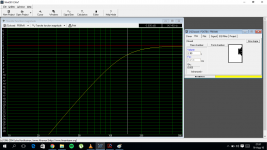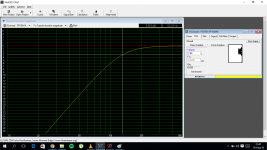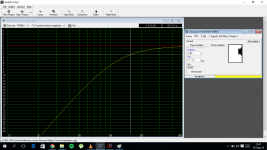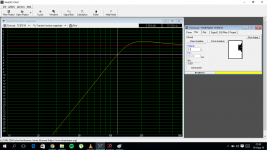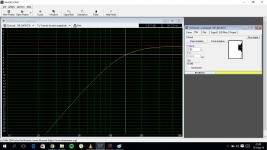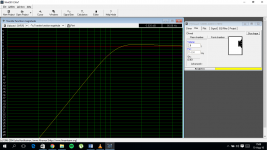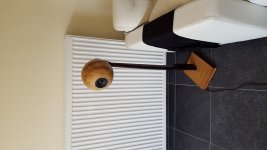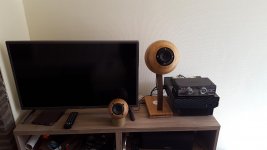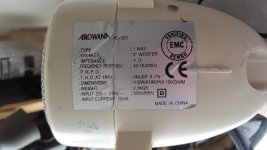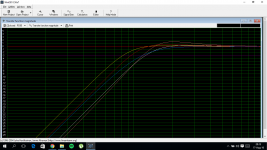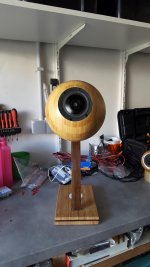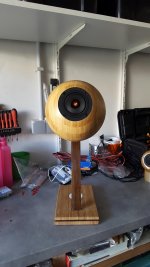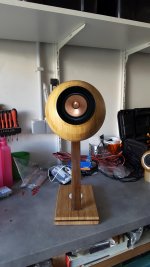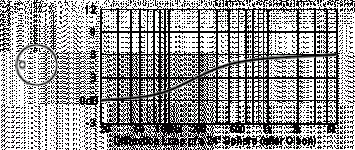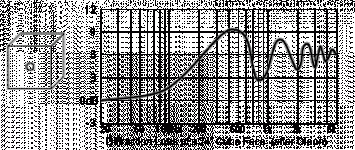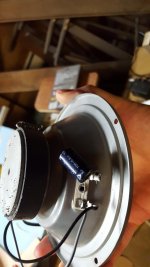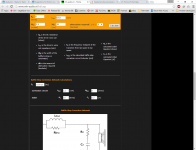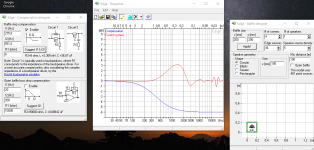Alright, so now that you have drivers rounded up, it's time to look what kind of real world performance they have. Hobbyist & magazine measurements can tell a lot more compared to manufacturer datasheets, which can be a little "beautified". Google is your friend in this. Here are good measurements for the drivers in your top 2:
Dayton Audio ND90
Mark Audio CHR-70
The main thing to look at here are frequency response and harmonic distortion. I couldn't find a good measurement for Hivi M3N, but the driver seems to be more of a midrange driver than full range, with manufacturer only specifying the usable range till 8kHz. I would drop that one out.
Out of these two, I'd choose the ND-90. If the shape of the flange concerns you, you can always 3d print a custom flange for them that fits your speakers better I've used 3dhubs.com to find local services. The prints are usually inexpensive if they are standard plastics.
I've used 3dhubs.com to find local services. The prints are usually inexpensive if they are standard plastics.
Dayton Audio ND90
Mark Audio CHR-70
The main thing to look at here are frequency response and harmonic distortion. I couldn't find a good measurement for Hivi M3N, but the driver seems to be more of a midrange driver than full range, with manufacturer only specifying the usable range till 8kHz. I would drop that one out.
Out of these two, I'd choose the ND-90. If the shape of the flange concerns you, you can always 3d print a custom flange for them that fits your speakers better
Last edited:
I tested these to, just to eliminate them from choice... if anybody wants to recreate the bowls with 20cm. Currently the best one is the dayton audio N90, I gonna read up on this little driver.
But a few question so far:
- Full-range 80 Hz to 15 kHz performance (do I have to worry about the ND90 that it can't reach 21kHz?)
- most video's I find are subwoofer or bass aplications, I don't want my speakers to be like individual woofers next to my subwoofer.
- the CHR-70 could be used to 25kHz and the difference on -3db is only 5Hz, so would this speaker give nicer/better sound at the high notes
- when you see the graph of the CHR-70 in winisd, there is a little hump... does that mean it is in a too small enclosure
fostex ff85WK
-3dB 147Hz
original volume: 1.90
FOSTEX FF105WK
-3dB 132Hz
original volume: 2.66
FOUNTEK FR89EX
-3dB 156Hz
original volume: 0.88
TYMPHANY TC9FD18
-3dB 117Hz
original volume: 5.03
SCANSPEEK 10F_8414G10
-3dB 141Hz
original volume: 1.8
Yeah I'm gonna have to use a 3D printer, because that would ruin the design. Thanks for the website, always handy
But a few question so far:
- Full-range 80 Hz to 15 kHz performance (do I have to worry about the ND90 that it can't reach 21kHz?)
- most video's I find are subwoofer or bass aplications, I don't want my speakers to be like individual woofers next to my subwoofer.
- the CHR-70 could be used to 25kHz and the difference on -3db is only 5Hz, so would this speaker give nicer/better sound at the high notes
- when you see the graph of the CHR-70 in winisd, there is a little hump... does that mean it is in a too small enclosure
fostex ff85WK
-3dB 147Hz
original volume: 1.90
FOSTEX FF105WK
-3dB 132Hz
original volume: 2.66
FOUNTEK FR89EX
-3dB 156Hz
original volume: 0.88
TYMPHANY TC9FD18
-3dB 117Hz
original volume: 5.03
SCANSPEEK 10F_8414G10
-3dB 141Hz
original volume: 1.8
Yeah I'm gonna have to use a 3D printer, because that would ruin the design. Thanks for the website, always handy
Attachments
- Full-range 80 Hz to 15 kHz performance (do I have to worry about the ND90 that it can't reach 21kHz?)
- most video's I find are subwoofer or bass aplications, I don't want my speakers to be like individual woofers next to my subwoofer.
The ND90 has +-4db to 20kHz response as measured by John Murphy on his page. It's not the optimal, but should work. Certainly gives the lowest bass extension, and that's likely the result why it's used as a bass driver.
- the CHR-70 could be used to 25kHz and the difference on -3db is only 5Hz, so would this speaker give nicer/better sound at the high notes
- when you see the graph of the CHR-70 in winisd, there is a little hump... does that mean it is in a too small enclosure
It is likely. I personally didn't like the CHR-70 that much, but that shouldn't stop other people from liking it
TYMPHANY TC9FD18
-3dB 117Hz
original volume: 5.03
TC9 is a solid driver. I've used it on one project and the forums are littered with different projects using this little driver. Another alternative you could think of is the Peerless P830986. You can order them from ebay or aliexpress, I linked one seller that I've used: GLOBLE HIFI SHOP
After looking at all those graphs and numbers, its still not easy picking my driver.
I made a phone call to soundimports (where I would order the speakers). The guy I spoke too, told me what I already was thinking... If I would like to use the ND90, he would recommend adding a tweeter (because it isn't really "full range").
So I asked what he tought of the PS95 (because I really like the copper phase plug), even do it has a higher -3db. He would use this one over the ND90 because if I'm going to add a sub going low on the speakers is less importand then good high notes.
The TYMPHANY TC9FD18 has a really dull look, it's a representation of how all speakers look... so in my design that would be a no-go. But the RS100 has 116, so about the same? I'm not gonna rule that one out, because I'm also doing this project to have some nice sound and not just the design.
So on regards to measurements, how would I gudge a "good" speaker? Currently I have made 2 speakers from my old 5.1:
- The small one and the one in the TV stand (They are L&R, in the original enclosure there was a tweeter)
- 1 floor stand speaker from a pc driver.
The 5.1 is a Creative inspire T5400
Low-range amp power: 22W
Satellite amp power: 4 x 8W
Center channel amp power: 20W
Frequency response: 40Hz - 20kHz
Front speaker size: 95mm X 197mm X 95mm
Rear speaker size: 95mm x 166mm x 95mm
Subwoofer size: 170mm X 285mm X 240mm
The one from the PC driver had this info on it:
Arowana JC7620
type: 1 way
speaker: 3" woofer
impedance: 4ohm
frequency response: 40-18.000Khz
T.H.D at 1kHz: under 0.1%
dimensions: 115x190x150
weight: 2.1Kg
input: 220v
Too what kind of audio tracks would I have to listen to hear a noticable difference? I can say that when I play the really small one next to my ear comparred to the one in the "TV stand", my ears start to hurt faster...is this a normal behavior when a driver is in a to small enclosure? Because then the CHR70 is a really No-go
I made a phone call to soundimports (where I would order the speakers). The guy I spoke too, told me what I already was thinking... If I would like to use the ND90, he would recommend adding a tweeter (because it isn't really "full range").
So I asked what he tought of the PS95 (because I really like the copper phase plug), even do it has a higher -3db. He would use this one over the ND90 because if I'm going to add a sub going low on the speakers is less importand then good high notes.
The TYMPHANY TC9FD18 has a really dull look, it's a representation of how all speakers look... so in my design that would be a no-go. But the RS100 has 116, so about the same? I'm not gonna rule that one out, because I'm also doing this project to have some nice sound and not just the design.
So on regards to measurements, how would I gudge a "good" speaker? Currently I have made 2 speakers from my old 5.1:
- The small one and the one in the TV stand (They are L&R, in the original enclosure there was a tweeter)
- 1 floor stand speaker from a pc driver.
The 5.1 is a Creative inspire T5400
Low-range amp power: 22W
Satellite amp power: 4 x 8W
Center channel amp power: 20W
Frequency response: 40Hz - 20kHz
Front speaker size: 95mm X 197mm X 95mm
Rear speaker size: 95mm x 166mm x 95mm
Subwoofer size: 170mm X 285mm X 240mm
The one from the PC driver had this info on it:
Arowana JC7620
type: 1 way
speaker: 3" woofer
impedance: 4ohm
frequency response: 40-18.000Khz
T.H.D at 1kHz: under 0.1%
dimensions: 115x190x150
weight: 2.1Kg
input: 220v
Too what kind of audio tracks would I have to listen to hear a noticable difference? I can say that when I play the really small one next to my ear comparred to the one in the "TV stand", my ears start to hurt faster...is this a normal behavior when a driver is in a to small enclosure? Because then the CHR70 is a really No-go
Attachments
fostex ff85WK
-3dB 147Hz
original volume: 1.90
FOSTEX FF105WK
-3dB 132Hz
original volume: 2.66
FOUNTEK FR89EX
-3dB 156Hz
original volume: 0.88
TYMPHANY TC9FD18
-3dB 117Hz
original volume: 5.03
SCANSPEEK 10F_8414G10
-3dB 141Hz
original volume: 1.8
Because the Qs differ those numbers are not directly comparable.
dave
Stupid question, but what does Qs stand for? If you mean the original volume, thats just what Winisd gave me and I changed it to 2.8 for all the -3db test.
So if you had to pick one, what would it be? Because I'm still having the feeling that this is guesswork for me, as long as I don't hear those speakers in real life. But now I at least know why they say building speakers is an artform.
So if you had to pick one, what would it be? Because I'm still having the feeling that this is guesswork for me, as long as I don't hear those speakers in real life. But now I at least know why they say building speakers is an artform.
Q is the "shape" of the roll-off.
F3 is a meaningless number as far as the ear/brain is concerned, and once you introduce different Qs then they are not directly comparable.
As far as real bass response look at F10 (and F6)
Typically you want to keep the Q between 0.5 and a bit less than 1.0. Between 0.5 and 0.707 is a more typical range. Adding damping to the box will increase its aparent volume and will lower the Q.
dave
F3 is a meaningless number as far as the ear/brain is concerned, and once you introduce different Qs then they are not directly comparable.
As far as real bass response look at F10 (and F6)
Typically you want to keep the Q between 0.5 and a bit less than 1.0. Between 0.5 and 0.707 is a more typical range. Adding damping to the box will increase its aparent volume and will lower the Q.
dave
-10db
dayton audio PS95 (white): 75Hz
dayton audio rs100 (bue): 66Hz
dayton audio ND90 (yellow) 49Hz
mark audio chr70 (red): 60Hz
Tymphany TC9 (pink): 80Hz
Just learned that I could put them together in winisd, so you mean like the red one? and adding damping would bring the pink one down.
dayton audio PS95 (white): 75Hz
dayton audio rs100 (bue): 66Hz
dayton audio ND90 (yellow) 49Hz
mark audio chr70 (red): 60Hz
Tymphany TC9 (pink): 80Hz
Just learned that I could put them together in winisd, so you mean like the red one? and adding damping would bring the pink one down.
Attachments
Is there a reason why most of you on the forum use Winisd? Because Boxsim seems better? "Boxsim also includes its own algorithm for simulating edge diffraction from the baffle (baffle step)"
Downloads
Downloads
An externally hosted image should be here but it was not working when we last tested it.
I tried Boxsim, but can't seem to find the frd & zma files for some speakers, does this have any reall difference? I have put them all in a box of 20*20*20 and the height of the speaker at 10*10.
From these lines I don't understand why the last part of the lines are "wavey", I did the B80 because then I would have a reference point with the others.
But from these graphs I would say the chr70 has an advantage over the rs100 in the low, but the ps95 has a real high spl compared to the rest.
Can you create a vented blanda matt version? Because now they all are closed, but wouldn"t that also give more bass
From these lines I don't understand why the last part of the lines are "wavey", I did the B80 because then I would have a reference point with the others.
But from these graphs I would say the chr70 has an advantage over the rs100 in the low, but the ps95 has a real high spl compared to the rest.
Can you create a vented blanda matt version? Because now they all are closed, but wouldn"t that also give more bass
Attachments
-
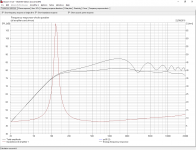 frequency response ps95.png38.2 KB · Views: 157
frequency response ps95.png38.2 KB · Views: 157 -
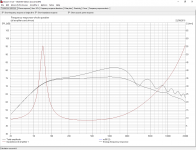 frequency response nd90.png38.8 KB · Views: 150
frequency response nd90.png38.8 KB · Views: 150 -
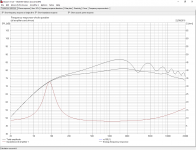 frequencu response rs100.png37.2 KB · Views: 162
frequencu response rs100.png37.2 KB · Views: 162 -
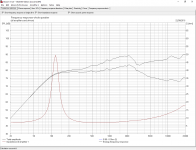 frequencu response b80.png57.3 KB · Views: 146
frequencu response b80.png57.3 KB · Views: 146 -
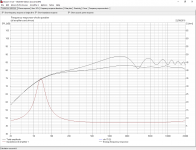 frequency response chr70.png36.1 KB · Views: 148
frequency response chr70.png36.1 KB · Views: 148 -
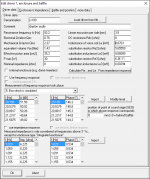 specs rs100.png25.7 KB · Views: 44
specs rs100.png25.7 KB · Views: 44 -
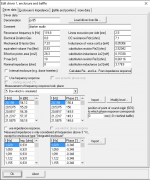 specs ps95.png28.5 KB · Views: 31
specs ps95.png28.5 KB · Views: 31 -
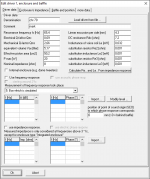 specs chr70.png24 KB · Views: 19
specs chr70.png24 KB · Views: 19 -
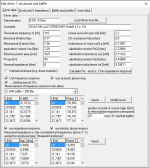 specs.png28.3 KB · Views: 25
specs.png28.3 KB · Views: 25
I did a simple photoshop and just asked some of my friends what they liked most in combination with my design. Almost none selected the chr70, most went for the RS100.
Personally I like the PS95 the most, but if I check the graphs the RS100 is better on paper... and if this really does correlate to a better sound I would take the RS100 over my personal choice. The salesmen I talked to today would recommand a tweeter with the RS100 and not with the PS95, do you agree?
On that note, could anybody tell me if the chr70 would sound better then the RS100 because on paper that one seems better (but would I hear it? I'm by no means an audio expert even after all I have read) And as user Mayuri didn't like his build, would the mark audio still be better then a dayton audio?
@Mayuri: in the beginning of this thread, you recommended the B80. Does this still stand after seeing the graph? And more importantly, is it worth twice the price of the others?
Personally I like the PS95 the most, but if I check the graphs the RS100 is better on paper... and if this really does correlate to a better sound I would take the RS100 over my personal choice. The salesmen I talked to today would recommand a tweeter with the RS100 and not with the PS95, do you agree?
On that note, could anybody tell me if the chr70 would sound better then the RS100 because on paper that one seems better (but would I hear it? I'm by no means an audio expert even after all I have read) And as user Mayuri didn't like his build, would the mark audio still be better then a dayton audio?
@Mayuri: in the beginning of this thread, you recommended the B80. Does this still stand after seeing the graph? And more importantly, is it worth twice the price of the others?
Attachments
It all depends on your budget mate. Visaton B80 is a good driver without doubt, but on the simulations it would require some filtering. With that and the higher price, I don't think it's the best in your build. Out of those that you simulated, I'd probably take the PS95. It was my favourite in the listening test ages ago. RS100 has lower HR response, but better bass. I think you'd be happy with either. Remember to order the BSC components which the calc suggests (round to nearest value sold, it's not 100% exact), otherwise it will sound very shallow due to baffle step. I keep pointing this out because at the start of my DIY career I neglected the need of BSC and then wondered why all my speakers sound so bad 
mh-audio.nl - Home
mh-audio.nl - Home
The problem is that I don't have a reference, I can't convince myself spending twice the amount on a driver that I have no clue about if I'm gonna hear something other then spectacular. Because if the sound would have minimal difference then that would be just like trowing money away.
I'm willing to spent some extra money on this project, but then it has to be justified. I know that this is still DIY and that the sound won't be that of a floor stand of €xxx.
On regards to Baffle step:
If I get the explanation right, it's more of lower frequencies are gonna be silent then oppost to higher frequencies. So screams are gonna sound 2x the sound of normal talking, but it should only be 1x louder... and those components are gonna normalize the sound level.
(I put a pic of a speaker from a friend, is this a component for the baffle step? Or is this for the frequency range?)
Because if you check the pics for the baffle step in a rectagular box, it has alot of the wavey line from my simulation instead of the sphere because I can't simulate a sphere (so wouldn't those calculations be off). Do you just buy those components at an electricity store?
Could you say why that PS95 has such a high spl in the simulation? Because it really stands out. But that would just mean that I don't have to turn the nob of the receiver high.
I want to order 2 speakers by the end of the weekend so I can have time to build, test and if necessary change driver. I first thought buying the RS100 so if they don't sound up to snuff, I could buy the visaton because they have similar looks. Or 2 PS95 at the front and the RS100 at the back?
I'm willing to spent some extra money on this project, but then it has to be justified. I know that this is still DIY and that the sound won't be that of a floor stand of €xxx.
On regards to Baffle step:
If I get the explanation right, it's more of lower frequencies are gonna be silent then oppost to higher frequencies. So screams are gonna sound 2x the sound of normal talking, but it should only be 1x louder... and those components are gonna normalize the sound level.
(I put a pic of a speaker from a friend, is this a component for the baffle step? Or is this for the frequency range?)
Because if you check the pics for the baffle step in a rectagular box, it has alot of the wavey line from my simulation instead of the sphere because I can't simulate a sphere (so wouldn't those calculations be off). Do you just buy those components at an electricity store?
Could you say why that PS95 has such a high spl in the simulation? Because it really stands out. But that would just mean that I don't have to turn the nob of the receiver high.
I want to order 2 speakers by the end of the weekend so I can have time to build, test and if necessary change driver. I first thought buying the RS100 so if they don't sound up to snuff, I could buy the visaton because they have similar looks. Or 2 PS95 at the front and the RS100 at the back?
Attachments
You should use similar drivers for all the speakers. If the sonic signatures of drivers are very different, it's going to start bothering you at some point. If 5x PS95 goes over the budget, you should buy 5x RS100. I'm not sure why the PS95 simulation is louder. The RS100 has higher efficiency, it should play louder. People in the forums have used it as full-range, I think you can find experiences with it with the search function.
The wavy line from the rectangular box is caused by the sound diffracting from multiple edges at different distances from eachother at a very steep angle (the edge is 90 degrees). With the sphere, the distance from driver center to the edge is the same from every point, and the curve of the baffle is very gradual, minimizing the diffraction. The baffle diffraction are very good with the spherical box, but you still need the BSC to attenuate the higher level of treble. Otherwise the sound will be very fatiguing and lifeless. There will be some bass, but the high frequencies will be about twice louder. Check the calculator I linked on how to solder it together. It only needs 4 components: 1 coil, 2 resistors and 1 capacitor. Usually the places that sell loudspeaker drivers also sell crossover etc. components.
The component you are showing is a capacitor across the speaker terminals. It's a very simple low-pass. Not very good one, because it's basically shorting the amplifier at high frequencies. Cheap manufacturers use those because they want to produce stuff as cheaply as possibly.
The wavy line from the rectangular box is caused by the sound diffracting from multiple edges at different distances from eachother at a very steep angle (the edge is 90 degrees). With the sphere, the distance from driver center to the edge is the same from every point, and the curve of the baffle is very gradual, minimizing the diffraction. The baffle diffraction are very good with the spherical box, but you still need the BSC to attenuate the higher level of treble. Otherwise the sound will be very fatiguing and lifeless. There will be some bass, but the high frequencies will be about twice louder. Check the calculator I linked on how to solder it together. It only needs 4 components: 1 coil, 2 resistors and 1 capacitor. Usually the places that sell loudspeaker drivers also sell crossover etc. components.
The component you are showing is a capacitor across the speaker terminals. It's a very simple low-pass. Not very good one, because it's basically shorting the amplifier at high frequencies. Cheap manufacturers use those because they want to produce stuff as cheaply as possibly.
Last edited:
Thanks for the tip on different drivers, didn't know that this would be a problem
Are these values correct? it's for a PS95.
Website:
F3: 1169.23
Lbsc: 1.1mH
Rz: 10 ohms
Rbsc: 8 ohms
Cz: 6.3 uF
Edge:
R2: 8 ohm
L: 2.308mH
C: 36.07uF
The PS95 is the cheapest of all, so budget wise that's not gonna break the bank. But what's the price for such BSC? Is that almost the same as the driver itself or just the price of a coffee?
1) PS95, 26€
2) CHR70, 35€
3) RS100, 40€
4) B80, 70€
I gotta say that for me this project isn't really fun anymore, I'm wasting to much time searching and at the end of the day I still feel that I don't know jack.
If I could request one thing is that some moderator makes a thread/sticky "Noobs Go Here" were you have some simple to the point information (basic & advanced), links to program's, good build video's, examples of bsc (real life and no diagrams), brands of speakers (in order of sales nr's or quality), and some other important info.
Are these values correct? it's for a PS95.
Website:
F3: 1169.23
Lbsc: 1.1mH
Rz: 10 ohms
Rbsc: 8 ohms
Cz: 6.3 uF
Edge:
R2: 8 ohm
L: 2.308mH
C: 36.07uF
The PS95 is the cheapest of all, so budget wise that's not gonna break the bank. But what's the price for such BSC? Is that almost the same as the driver itself or just the price of a coffee?
1) PS95, 26€
2) CHR70, 35€
3) RS100, 40€
4) B80, 70€
I gotta say that for me this project isn't really fun anymore, I'm wasting to much time searching and at the end of the day I still feel that I don't know jack.
If I could request one thing is that some moderator makes a thread/sticky "Noobs Go Here" were you have some simple to the point information (basic & advanced), links to program's, good build video's, examples of bsc (real life and no diagrams), brands of speakers (in order of sales nr's or quality), and some other important info.
Attachments
I think your baffle width is larger, you only put in 10cm baffle on the calculator. Edge is also good, but it leaves the Zobel circuit out of it. I think you could do without it as well, as this is a single-driver application. If you have multiple drivers then zobel is more needed.
The edge simulates full -6db BSC which is for completely empty space. If you put it in a echoless room, it will sound good. In a normal room, -3/4db is enough, with -6db you will have too much low frequencies. If your speakers are next to a wall, -3db is good. If they are away from wall, -4db. If they are in a corner, -2db would do. I prefer the online calculator in this as it will let you choose the attenuation. Overall, I personally prefer -3db BSC for all applications. Ferrite core coil and 5W resistors are ok, they should cost under 10€ per driver. If the PS95 is the cheapest, definedly go for it! It's excellent.
Hang in there mate, you are just about done with the design. The start is the roughest part as everyone starts from square one. I didn't know jack about anything when I build my first speakers that I designed myself, and they were full of flaws. I think you will be happy again with the project when you get the drivers & parts at hand
The edge simulates full -6db BSC which is for completely empty space. If you put it in a echoless room, it will sound good. In a normal room, -3/4db is enough, with -6db you will have too much low frequencies. If your speakers are next to a wall, -3db is good. If they are away from wall, -4db. If they are in a corner, -2db would do. I prefer the online calculator in this as it will let you choose the attenuation. Overall, I personally prefer -3db BSC for all applications. Ferrite core coil and 5W resistors are ok, they should cost under 10€ per driver. If the PS95 is the cheapest, definedly go for it! It's excellent.
Hang in there mate, you are just about done with the design. The start is the roughest part as everyone starts from square one. I didn't know jack about anything when I build my first speakers that I designed myself, and they were full of flaws. I think you will be happy again with the project when you get the drivers & parts at hand
Last edited:
I received an email back from the electricity store, asking what kind of voltage, wire tickness, type of coil I wanted. And there I was back at square one ;-)
He uses the ones from Visaton, but they don't have 5W only 10W ceramic resistors. What coil do I use, because the lowest one they have is LR ferrit coils 1,5mH (but this has been adjusted with tin, not blank copper)
LR ferrit coils
I called the shop from where I want to order the drivers (soundimports) and they could order it for me from dayton audio, but they don't have stock so that would mean waiting 3 weeks for those parts.
Well I put 10cm in the baffle because it's a sphere with 20cm diameter and the driver is 9.5 in diameter. So that leaves 10cm, 5cm on each side. Or do I overlook something?
Can you tell me how you got to those values? Because I would like to know how you get to 5w and the other values, because if I use the website for -3dB I get this:
Lbsc: 0.4 Mh
Rz: 8,875
Rbsc: 2.9 ohms
Cz: 8
Do those coils and resistors take up lots of space? because those are gonna be on the inside of the bowl and I will want to mount them on the wooden spacer in the middle (in case I need to replace them)
I really do appreciate that you keep helping me Mayuri, I know otherwise that this project would've turned out different. So thank you
When I do get my hands on something that I can tinker with it's gonna change how I feel because now everything that I read is all theoretical and I can't translate those waves and values yet into something I know. If you see a graph you can translate it in "ahh, thats gonna sound like sh*t or hmm, better then I expected".
I will build one with the bsc and one without (temporary), just so I could hear the difference and then have a Eureka moment ;-)
He uses the ones from Visaton, but they don't have 5W only 10W ceramic resistors. What coil do I use, because the lowest one they have is LR ferrit coils 1,5mH (but this has been adjusted with tin, not blank copper)
LR ferrit coils
I called the shop from where I want to order the drivers (soundimports) and they could order it for me from dayton audio, but they don't have stock so that would mean waiting 3 weeks for those parts.
Well I put 10cm in the baffle because it's a sphere with 20cm diameter and the driver is 9.5 in diameter. So that leaves 10cm, 5cm on each side. Or do I overlook something?
Can you tell me how you got to those values? Because I would like to know how you get to 5w and the other values, because if I use the website for -3dB I get this:
Lbsc: 0.4 Mh
Rz: 8,875
Rbsc: 2.9 ohms
Cz: 8
Do those coils and resistors take up lots of space? because those are gonna be on the inside of the bowl and I will want to mount them on the wooden spacer in the middle (in case I need to replace them)
I really do appreciate that you keep helping me Mayuri, I know otherwise that this project would've turned out different. So thank you
When I do get my hands on something that I can tinker with it's gonna change how I feel because now everything that I read is all theoretical and I can't translate those waves and values yet into something I know. If you see a graph you can translate it in "ahh, thats gonna sound like sh*t or hmm, better then I expected".
I will build one with the bsc and one without (temporary), just so I could hear the difference and then have a Eureka moment ;-)
Last edited:
- Status
- This old topic is closed. If you want to reopen this topic, contact a moderator using the "Report Post" button.
- Home
- Loudspeakers
- Full Range
- Suggestions for 8ohm max 4" for Blanda matt 5.1
